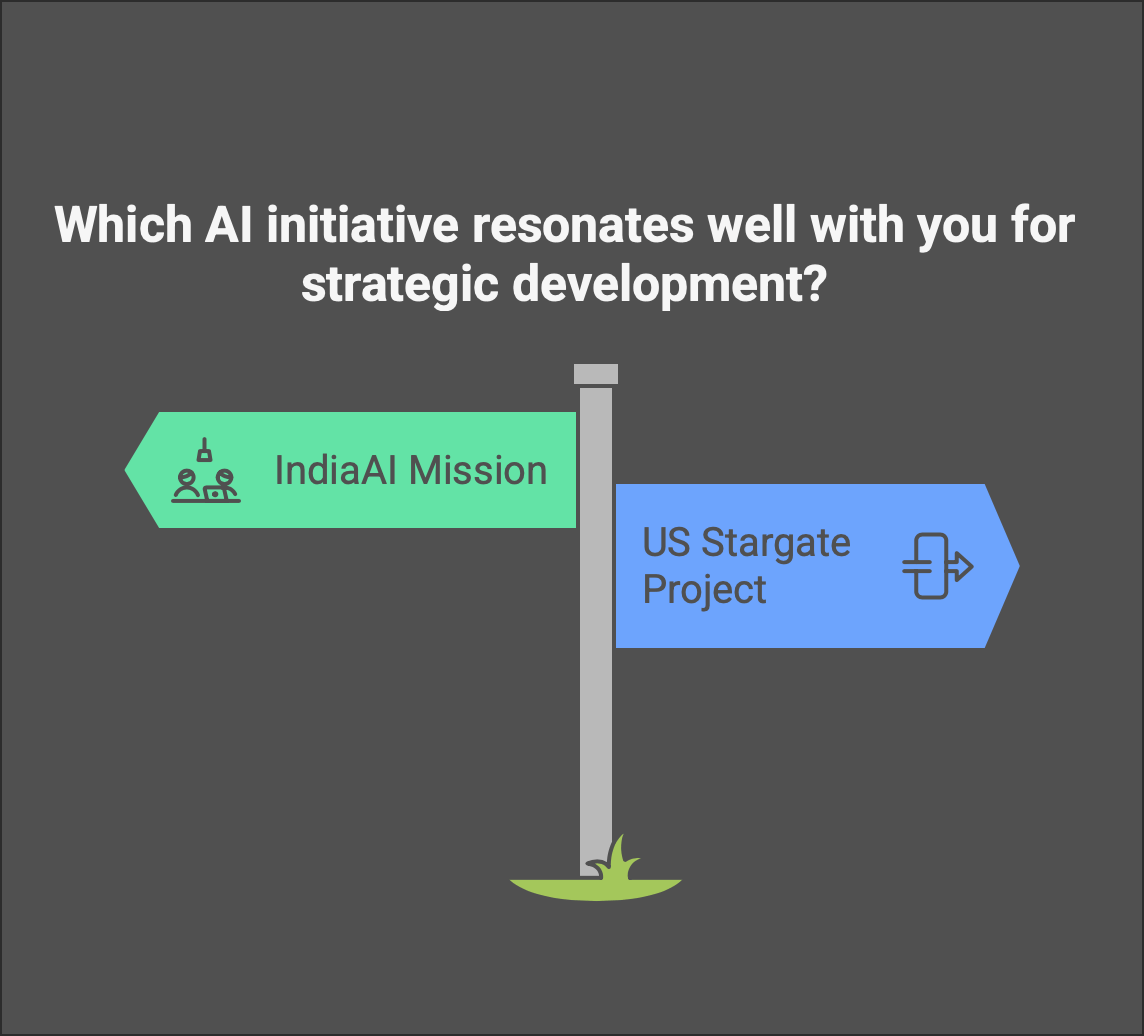- Solve for Earth.AI
- Posts
- Comparing IndiaAI Mission and US Stargate Project: Ambitions in AI Leadership
Comparing IndiaAI Mission and US Stargate Project: Ambitions in AI Leadership
While both initiatives cater to vastly different economic realities, they share a common vision of harnessing AI's transformative potential. By fostering collaboration rather than competition, these projects could collectively advance global progress in artificial intelligence.

The IndiaAI Mission and the US Stargate Project represent two distinct approaches to advancing artificial intelligence (AI) ecosystems, shaped by their respective national priorities, economic realities, and global ambitions. While both initiatives aim to bolster AI capabilities, their scales, strategies, and objectives reflect the differing contexts of a developing economy like India and a global superpower like the United States.

Key Comparisons
Aspect | IndiaAI Mission | US Stargate Project |
|---|---|---|
Budget | ₹10,372 crore (~$1.25 billion) over five years [3][4]. | $500 billion over four years [3][5]. |
Primary Goal | Democratize AI for socio-economic transformation in sectors like healthcare, agriculture, and education [3][4]. | Establish global AI dominance with a focus on AGI (Artificial General Intelligence) and large-scale infrastructure [3][5]. |
Scale of Infrastructure | Development of scalable AI infrastructure with 10,000 GPUs through public-private partnerships [3][4]. | Construction of 20 advanced data centers across the US to power AI innovations [3][5]. |
Funding Model | Public-private partnership with government leadership [3][4]. | Private-sector-led funding with companies like OpenAI, SoftBank, and Oracle taking the lead [3][5]. |
Job Creation | Focus on skill development through FutureSkills programs and Data/AI Labs in smaller towns [3][4]. | Over 100,000 jobs expected in construction, operations, and AI research [5]. |
Global Collaboration | Emphasizes partnerships under frameworks like iCET (Indo-US Critical Emerging Technology) [1][2]. | Primarily US-focused but offers indirect opportunities for Indian talent and industries [1][2][5]. |
Strategic Vision | "Make AI in India" and "Make AI Work for India" to address domestic challenges while fostering innovation [3][4]. | Maintain US leadership in AI through massive investments in infrastructure and talent development [5][6]. |
Strengths of Each Initiative
IndiaAI Mission
Inclusivity and Socio-Economic Focus: IndiaAI aims to democratize AI by targeting critical sectors like healthcare, agriculture, and education. This approach aligns with India's developmental priorities and addresses grassroots challenges [3][4].
Talent Development: By expanding AI education through graduate programs and establishing Data/AI Labs in smaller towns, the mission seeks to build a broad talent base [3].
Cost-Effective Innovation: With a smaller budget compared to Stargate, IndiaAI focuses on leveraging existing resources efficiently while fostering innovation through startups and researchers [3].
US Stargate Project
Scale and Ambition: The $500 billion budget reflects the US's intent to dominate the global AI landscape by building unparalleled infrastructure for AGI development [3][5].
Private-Sector Leadership: Backed by tech giants like OpenAI, Nvidia, Oracle, and SoftBank, Stargate benefits from cutting-edge expertise and financial muscle [3][5].
Global Standards Setting: By investing heavily in data centers and foundational models, the project positions the US as a leader in setting global benchmarks for AI technologies [5].
Challenges for Both Initiatives

IndiaAI Mission
Limited financial resources compared to global competitors like Stargate.
Dependence on international collaborations for advanced technologies due to gaps in domestic hardware capabilities [4].
Need for stronger private-sector involvement to scale efforts effectively [4].
US Stargate Project
Potential geopolitical concerns over monopolizing key AI technologies.
Environmental impact of large-scale data centers.
High reliance on private funding could limit public accountability or equitable access to outcomes [5].
Opportunities for Collaboration
Despite their differences, these initiatives offer avenues for mutual benefit:
Talent Exchange: Indian professionals can contribute to Stargate's projects while gaining exposure to cutting-edge technologies [1][2].
Knowledge Transfer: Lessons from Stargate's scale can inform India's efforts to expand its own AI infrastructure efficiently [2].
Strategic Partnerships: Frameworks like iCET can facilitate joint research projects and co-development of technologies between India and the US [1].
Conclusion
The IndiaAI Mission reflects India's pragmatic approach to leveraging AI for inclusive growth within its economic constraints. In contrast, the US Stargate Project underscores America's ambition to maintain global dominance in AI through unmatched investments. While both initiatives cater to vastly different economic realities, they share a common vision of harnessing AI's transformative potential. By fostering collaboration rather than competition, these projects could collectively advance global progress in artificial intelligence.
Citations: [1] https://ddnews.gov.in/en/500-billion-stargate-ai-project-in-us-presents-golden-opportunity-for-india-industry/
[5] https://timesofindia.indiatimes.com/technology/times-techies/india-must-rise-to-americas-500-billion-stargate-challenge/articleshow/117503038.cms [6] https://www.communicationstoday.co.in/india-eyes-opportunity-in-trumps-500b-stargate-ai-project/